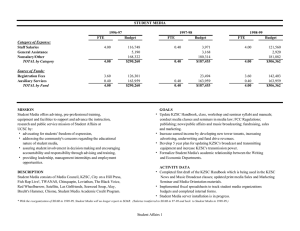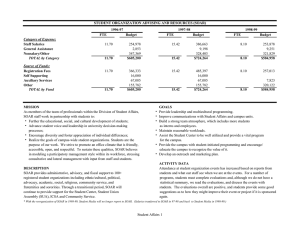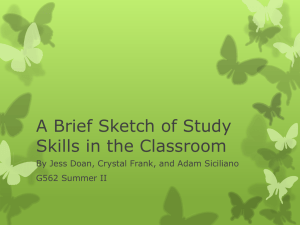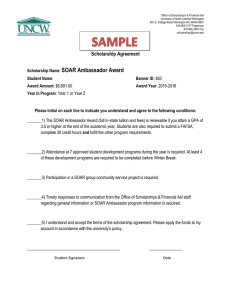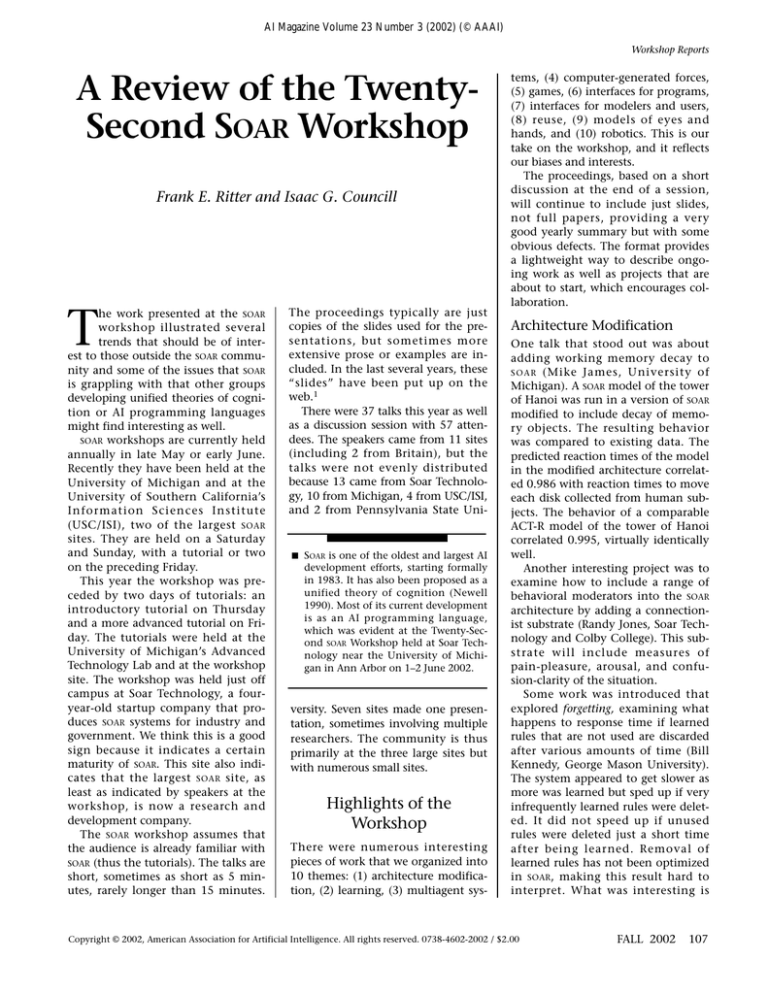
AI Magazine Volume 23 Number 3 (2002) (© AAAI)
Workshop Reports
A Review of the TwentySecond SOAR Workshop
Frank E. Ritter and Isaac G. Councill
T
he work presented at the SOAR
workshop illustrated several
trends that should be of interest to those outside the SOAR community and some of the issues that SOAR
is grappling with that other groups
developing unified theories of cognition or AI programming languages
might find interesting as well.
SOAR workshops are currently held
annually in late May or early June.
Recently they have been held at the
University of Michigan and at the
University of Southern California’s
Information Sciences Institute
(USC/ISI), two of the largest SOAR
sites. They are held on a Saturday
and Sunday, with a tutorial or two
on the preceding Friday.
This year the workshop was preceded by two days of tutorials: an
introductory tutorial on Thursday
and a more advanced tutorial on Friday. The tutorials were held at the
University of Michigan’s Advanced
Technology Lab and at the workshop
site. The workshop was held just off
campus at Soar Technology, a fouryear-old startup company that produces SOAR systems for industry and
government. We think this is a good
sign because it indicates a certain
maturity of SOAR. This site also indicates that the largest SOAR site, as
least as indicated by speakers at the
workshop, is now a research and
development company.
The SOAR workshop assumes that
the audience is already familiar with
SOAR (thus the tutorials). The talks are
short, sometimes as short as 5 minutes, rarely longer than 15 minutes.
The proceedings typically are just
copies of the slides used for the presentations, but sometimes more
extensive prose or examples are included. In the last several years, these
“slides” have been put up on the
web.1
There were 37 talks this year as well
as a discussion session with 57 attendees. The speakers came from 11 sites
(including 2 from Britain), but the
talks were not evenly distributed
because 13 came from Soar Technology, 10 from Michigan, 4 from USC/ISI,
and 2 from Pennsylvania State Uni-
■ SOAR is one of the oldest and largest AI
development efforts, starting formally
in 1983. It has also been proposed as a
unified theory of cognition (Newell
1990). Most of its current development
is as an AI programming language,
which was evident at the Twenty-Second SOAR Workshop held at Soar Technology near the University of Michigan in Ann Arbor on 1–2 June 2002.
versity. Seven sites made one presentation, sometimes involving multiple
researchers. The community is thus
primarily at the three large sites but
with numerous small sites.
Highlights of the
Workshop
There were numerous interesting
pieces of work that we organized into
10 themes: (1) architecture modification, (2) learning, (3) multiagent sys-
tems, (4) computer-generated forces,
(5) games, (6) interfaces for programs,
(7) interfaces for modelers and users,
(8) reuse, (9) models of eyes and
hands, and (10) robotics. This is our
take on the workshop, and it reflects
our biases and interests.
The proceedings, based on a short
discussion at the end of a session,
will continue to include just slides,
not full papers, providing a very
good yearly summary but with some
obvious defects. The format provides
a lightweight way to describe ongoing work as well as projects that are
about to start, which encourages collaboration.
Architecture Modification
One talk that stood out was about
adding working memory decay to
S O A R (Mike James, University of
Michigan). A SOAR model of the tower
of Hanoi was run in a version of SOAR
modified to include decay of memory objects. The resulting behavior
was compared to existing data. The
predicted reaction times of the model
in the modified architecture correlated 0.986 with reaction times to move
each disk collected from human subjects. The behavior of a comparable
ACT-R model of the tower of Hanoi
correlated 0.995, virtually identically
well.
Another interesting project was to
examine how to include a range of
behavioral moderators into the SOAR
architecture by adding a connectionist substrate (Randy Jones, Soar Technology and Colby College). This substrate will include measures of
pain-pleasure, arousal, and confusion-clarity of the situation.
Some work was introduced that
explored forgetting, examining what
happens to response time if learned
rules that are not used are discarded
after various amounts of time (Bill
Kennedy, George Mason University).
The system appeared to get slower as
more was learned but sped up if very
infrequently learned rules were deleted. It did not speed up if unused
rules were deleted just a short time
after being learned. Removal of
learned rules has not been optimized
in SOAR, making this result hard to
interpret. What was interesting is
Copyright © 2002, American Association for Artificial Intelligence. All rights reserved. 0738-4602-2002 / $2.00
FALL 2002
107
Workshop Reports
that the results to us appear to be
consistent with Doorenbos’s results
that show a small rate of slowdown
as new rules are learned (Doorenbos,
Tambe, and Newell 1992).
ence Applications International Corporation; Wray; Michael van Lent,
Institute for Creative Technologies;
Jones; Beisaw; and Wallace).
Learning
Laird believes that computer games
are an important and useful application for AI models. 2 Several folks
working with Laird presented work
on creating SOAR models for populating computer games, including a
haunted house game (John Laird,
University of Michigan) and military
tactics games, both as an individual
in a first-person shooter like UNREAL
TOURNAMENT as well as small squad
games (van Lent). Agents are being
built to serve as opponents and sometimes assistants and colleagues. Exploratory work is being conducted
that aims to put SOAR into the role of
an interactive story director (Brian
Magerko, University of Michigan) as
well as provide directable characters
within the story (Mazin Assanie, University of Michigan). Some work was
presented dealing with interfacing
SOAR to the UNREAL game environment
(Devvan Stokes and Alex Kerfoot,
both of University of Michigan).
There were several projects that
included new approaches or types of
learning. These projects, some in an
early stage, integrated learning by
observation using inductive logic
programming (Tolga Konik and John
Hawkins, both of University of
Michigan), learning through selfexplanation (Jones), reusing and testing of the previous symbolic concept
acquisition model in ACT- R (Robert
Wray, Soar Technology), making of
learning and behavior more robust
(Jennifer Kiessel, Paul Nielsen, and
Jonathan Beard, all of Soar Technology), the learning of how to recover
from lack of knowledge but with
some domain-specific yet slightly
general knowledge (Kiessel), and a
project attempting to discover errors
in behavior by having agents catch
their own errors (Scott Wallace, University of Michigan).
Multiagent Systems
Many of the projects that were about
modeling human or agent behavior
also concerned themselves with multiple agents, including models of
teamwork, communication between
agents, and motivation of other
agents (Andrew Nuxoll, University of
Michigan, and James Beisaw and
Glenn Taylor, both of Soar Technology). Another interesting project examined conflict resolution and the possible dilemmas that can arise when
problem solving is not rational (Tony
Kalus, University of Portsmouth).
Games
Interfaces for Programs
Several talks reported projects that
provide various types and levels of
application program interfaces (APIs)
to SOAR . These APIs are to support
projects that need to embed SOAR and
provide a more uniform and steady
approach to building tools that work
with and for SOAR. None have been
released, but two are promised shortly (Jens Wessling, Soar Technology,
and Douglas Pearson, Three Penny
Software).
Computer-Generated Forces
Interfaces for
Modelers and Users
The largest current (but certainly not
only) application of SOAR is for computer-generated forces, that is, modeling humans and combat vehicles in
military simulations. In addition to
being the application domain of several other talks, work was presented
on modeling urban combat with SOAR
in ONESAF (a simulation tool for synthetic environments) and in a variety
of other projects (Douglas Reece, Sci-
Many in the SOAR community are
realizing that interfaces for teaching
users and developing SOAR models
(broadly defined) need to be improved. Several of the papers were
about user interfaces or had aspects
related to user interfaces. Several
groups are working on extending programmer interfaces to SOAR (Brian
Harleton, University of Michigan,
and Jacob Crossman, Soar Technolo-
108
AI MAGAZINE
gy). Interface usability concerns were
addressed with a task analysis (Frank
Ritter, Pennsylvania State University),
a new toolkit for creating displays for
SOAR models was presented (Taylor),
and at least two groups are working
on adding explanation capabilities to
SOAR (van Lent and Isaac Councill,
Pennsylvania State University).
Reuse
One of the main reasons for working
within a cognitive architecture,
according to Newell, is to encourage
theory cumulation and reuse. In a
cognitive architecture such as SOAR,
because theories are represented as
programs, production rules (knowledge), or changes to the architecture
(primitive capabilities), this reuse has
to mean at least the reuse of ideas,
but more likely needs to mean the
reuse of systems and knowledge sets.
We believe that reuse has been a continual problem in SOAR.
There are examples of reuse within
the SOAR community, and a few were
presented here. A theory of concept
acquisition was reused and is being
extended to match a large pot of data
for a cognitive model comparison
exercise (Wray).
NL - SOAR , a theory of how natural
language is realized in SOAR, continues to be developed (Deryle Lonsdale,
Brigham Young University). When it
is complete, and available, it can be a
widely used (and thus reused) theory
of natural language understanding.
More than one of the speakers
reported a new and clearly useful tool
for writing, editing, and augmenting
SOAR code. The last speaker was asked
what the take-home message was.
Was it that the tool would be released
or that notes on the technique would
be made available, or was he just
teasing us? For far too many reports
(including one of ours), it appears
that the answer was that we are just
being teased.
Models of Eyes and Hands
A model was reported that interacted
with an interface based on the picture on the screen (van Lent). Image
processing was used to derive environmental structure, that is, where
buildings were and where doorways
Workshop Reports
were in a synthetic environment.
This spatial map was then used in
several ways to generate motion
through the environment.
Interaction based on working
through the display is a useful step
for making SOAR less dependent on
instrumented ties to particular interfaces. This approach appears to be
similar to St. Amants’ S EG M AN approach (St. Amant and Riedl 2001),
but the approach discussed by van
Lent is still tied lightly to this synthetic environment.
Robotics
A SOAR model is being prepared to fly
an unmanned air vehicle in the United Kingdom (Bill Smith, BlueBear Systems Research). The plane has been
selected, and the initial SOAR model is
currently generating and flying
routes in a simulation. This simulation is exciting because it shows
another application of SOAR as an
autonomous agent. Also reported
with this project was a clever hack for
quickly loading information into
SOAR by parsing a map database into
SOAR rules that augment SOAR’s initial
working memory with the contents
of the database as SOAR starts up.
Another talk introduced a small robot
whose small head (about 32K of random-access memory!) was filled with
SOAR and was able to follow a line on
the speaker’s table (Waterson).
The Future
Work on SOAR continues to present
new applications and new algorithms
for learning and behavior in a variety
of areas. In this sense, work with SOAR
is progressing and rightfully has the
attention of people who do not
directly use SOAR.
Cognitive models, in addition to
the AI projects, are still occurring
within SOAR . There were models of
concept acquisition, natural language
recognition, and problem solving.
This work has not disappeared; it just
appears in slightly different form.
One of the papers compared SOAR
with respect to beliefs, desires, and
intentions architectures and GOMS
(John and Kieras 1996), noting
many commonalities of component
structure, particularly how these perspectives share similar architectural
components on the problem-space
level (Jones). The analysis highlighted several aspects of behavior that
might currently be missing from
many of these approaches, such as
parallel active goals.
At the same time, there are areas
where Newell’s dream is not being
realized; these areas are difficult for
all groups working on cognitive
architecture, and the answers are not
easy. Theory cumulation, model
reuse, and interfaces that promote
the spread and uptake of this scientific approach are important, we believe
(we also work in the area of human
and computer interaction, so we are
particularly interested in these issues). Newell said, and we agree, that
science like politics is the art of the
possible. Cognitive modeling needs
to be more possible. A few good
things in SOAR that other communities can emulate include a variety of
mailing lists, 3 the help that often
arises from diverse members of the
community requesting the lists, the
annual workshop, central source code
maintenance, a web site,4 and a frequently asked questions list.5
If you would like to know more,
the proceedings are online at the SOAR
web site. A tutorial was offered at the
Cognitive Science Conference at
George Mason University on 7 to 10
August 2002. 6 If you would like to
learn more in a hands-on format, a
tutorial will perhaps be held at the
International Conference on Cognitive Modeling in Bamberg, Germany,
in April 2003.7 More will be offered at
the next SOAR workshop, to be held at
the University of Michigan in 2003.
It will be SOAR ’s twentieth anniversary, so extended tutorials and commentaries are being planned, a festival of SOAR perhaps.
ple/laird/papers/AI-games.pdf.
3. soar-requests@umich.edu for inquiries
and subscriptions.
4. ai.eecs.umich.edu/soar/.
5. acs.ist.psu.edu/soar-faq/.
6. hfac.gmu.edu/~cogsci/cogsci.html.
7. iccm2003.ppp.uni-bamberg.de.
References
Doorenbos, R.; Tambe, M.; and Newell, A.
1992. Learning 10,000 Chunks: What’s It
Like Out There? In Proceedings of the
Tenth National Conference on Artificial
Intelligence, 830–836. Menlo Park, Calif.:
American Association for Artificial Intelligence.
John, B. E., and Kieras, D. E. 1996. The
GOMS Family of User Interface Analysis
Techniques: Comparison and Contrast.
ACM Transactions on Computer-Human
Interaction 3(4): 320–351.
Newell, A. 1990. Unified Theories of Cognition. Cambridge, Mass.: Harvard University Press.
St. Amant, R., and Riedl, M. O. 2001. A
Perception/Action Substrate for Cognitive
Modeling in HCI. International Journal of
Human-Computer Studies 55(1): 15–39.
Frank E. Ritter helped start The School of
Information Sciences and Technology, a
new interdisciplinary academic unit at
Pennsylvania State University to study
how people process information using
technology and train leaders for the digital economy. Ritter earned his Ph.D. in AI
and psychology, an M.S. in psychology
from Carnegie-Mellon University, and a
BSEE (with honors) from UIUC. His e-mail
address is frank.ritter@psu.edu.
Isaac G. Councill is a granduate student in
Pennsylvania State University’s new School
of Information Sciences and Technology.
He earned his B.A. in psychology at the
University of North Carolina at Asheville.
His e-mail address is igc2@psu.edu.
Notes
1. S O A R Workshop 21 (2001): ai.eecs.
umich.edu/soar/workshop21/talks/; SOAR
Workshop 20 (2000): www.isi.edu/soar/
soar-workshop/proceedings.html. The
2002 proceedings are at www.soartech.
com/Soar22/SoarWorkshop22.html.
2. J. Laird and M. van Lent. 2001. Interactive Computer Games: Human-Level AI’s
Killer Application. ai.eecs.umich.edu/peo-
FALL 2002
109
Calendar of Events
Tokyo 101-8430 Japan
Voice: 81-3-4212-2554
E-mail: ksatoh@nii.ac.jp
www.dfki.de/~lange/ds2002.html
December 2002
September 2002
SEPTEMBER 24–27
Engineering of Intelligent Systems
(EIS'2002). Malaga, Spain
■
Contact:
Nicole Elzebroek
NAISO Natural and
Artificial Intelligence
Systems Organization
Parabool 160
Sliedrecht 3364 DH The Netherlands
Voice: 31 184-496999
E-mail: eis2002@global-conf.org
www.icsc-naiso.org/conferences/
eis2002
SEPTEMBER 29
Ubicomp-2002 Workshop on Cognitive Aids. Stockholm, Sweden
■
■
Sponsor:
The Fourth International Conference
on Ubiquitous Computing
Contact:
Henry Kautz
University of Washington
Computer Science and Engineering
Sieg Hall, Box 352350
Seattle, WA 98195
Voice: 206-543-1896
E-mail: kautz@cs.washington.edu
www.cs.washington.edu/homes/kautz/
ubicog
November 2002
NOVEMBER 4–7
NOVEMBER 8–10
The 2002 Fall Symposium Series.
Cape Cod, MA
■
■
Sponsors:
SAP, WH&P
■
Paper Submission Deadline:
October 15, 2002
■
Contact:
Alison Rowles
SMP-M Events
Le Saugey
Fechy 1173 Switzerland
Voice: 41-21 807 1675
E-mail: alison@smp-m.com
www.lisa.org/events/2002europe/
110
AI MAGAZINE
Contact:
AAAI
445 Burgess Drive
Menlo Park, CA 94025
Voice: 1-650-328-3123
E-mail: fss@aaai.org
www.aaai.org/Symposia/Fall/2002/
fss-02.html
JURIX 2002: Fifteenth Annual
International Conference on Legal
Knowledge and Information Systems.
London, UK
■
Sponsors:
The JURIX Foundation, The Institute of
Advanced Legal Studies, UK, The Faculty of Law, King's College London, UK
■
Paper Submission Deadline:
September 23, 2002
■
Contact:
Aspassia Daskalopulu
King's College London
Computer Science
The Strand London WC2R 2LS UK
Voice: +44-(0)207 848 2987
Fax: +44-(0)207 240 1071
E-mail: jurix02@dcs.kcl.ac.uk
www.dcs.kcl.ac.uk/staff/aspassia/jurix02
NOVEMBER 18–20
IASTED International Conference on
Information and Knowledge Sharing
(IKS 2002). St. Thomas, US Virgin
Islands
■
■
Sponsors:
IASTED, University of the Virgin
Islands
Contact:
Katherine Ruelle
IASTED–International Association of
Science and Technology for Development #80, 4500 - 16th Avenue NW
Calgary, AB T3B 0M6 Canada
Voice: 403-288-1195
E-mail: calgary@iasted.com
www.iasted.org/conferences/2002/vi/iks
.htm
DECEMBER 18–21
International Conference on Knowledge-Based Computer Systems. Mumbai, India
■
NOVEMBER 24–26
The Fifth International Conference
on Discovery Science (DS2002). Luebeck, Germany
■
LISA Forum Europe and Annual
Meeting. Heidelberg, Germany
■
Sponsor:
American Association for Artificial
Intelligence
DECEMBER 16–17
Contact:
Ken Satoh
National Institute of Informatics
2-1-2 Hitotsubashi
Tokyo 101-8430 Japan
Voice: 81-3-4212-2554
E-mail: ksatoh@nii.ac.jp
www.dfki.de/~lange/ds2002.html
Contact:
KBCS-2002 Secretariat
National Centre for Software
Technology
Knowledge Based Computer System
Gulmohar Cross Rd No. 9, Juhu
Mumbai 400 049 India
Voice: 91-22-6201606
Fax: 91-22-6210139
E-mail: kbcs@ncst.ernet.in
www.ncst.ernet.in/kbcs2002
January 2003
JANUARY 12–15
The Seventh International Conference on Intelligent User Interfaces.
Miami Beach, FL
■
Sponsors:
ACM, SIGART, SIGCHI, AAAI, BCS-HCI,
RedWhale Software Corporation,
Microsoft Corporation
NOVEMBER 24–26
■
The Fifth International Conference
on Discovery Science (DS2002). Luebeck, Germany
Paper Submission Deadline:
October 4, 2002
■
Contact:
David Leake
Indiana University Computer Science
150 S. Woodlawn Avenue
Bloomington, IN 47405
Voice: 812-855-9756
■
Contact:
Ken Satoh
National Institute of Informatics
2-1-2 Hitotsubashi
Calendar
Fax: 812-855-4829
E-mail: leake@cs.indiana.edu
www.iuiconf.org/
March 2003
MARCH 9–12
Computer Applications in Health Care. Melbourne, FL
■
Sponsors:
ACM, SIGAPP
■
Contact:
Valentin Masero, University of Extremadura, Computer Science
Department, Avda. Universidad, s-n, Caceres 10071 Spain
Voice: 34-927257806
E-mail: vmasero@unex.es
webepcc.unex.es/vmasero/compahec/
April 2003
APRIL 23–26
ICEIS 2003—Fifth International Conference on Enterprise
Information Systems. Angers, France
■
Paper Submission Deadline:
October 15, 2002
■
Contact:
ICEIS-2003 Secretariat ESEO - ecole Superieure d' electronique
de l' Ouest 4, rue Merlet de la Boulaye - BP926 - 49009 Angers
CEDEX 01 France
Voice: 33-2 41 86 67 19
E-mail: secretariat@iceis.org
www.iceis.org
June 2003
JUNE 23–26
Sixteenth International Conference on Industrial and
Engineering Applications of Artificial Intelligence and
Expert Systems IEA/AIE-2003. Loughborough, England, UK
■
Sponsors:
International Society of Applied Intelligence ISAI, Southwest
Texas State University (SWT), Loughborough University (LU)
■
Paper Submission Deadline:
November 12, 2002
■
Contact:
Paul Chung, Loughborough University, Dept. of Computer Science, Loughborough Leicestershire LE11 3TU England, UK
Voice: 44-0 1509 222543
Fax: 44-0 1509 211586
E-mail: p.w.h.chung @lboro.ac.uk
gradients.lboro.ac.uk/ iea2003aie
JUNE 24–27
NAISO Conference on Information Technologies in Environmental Engineering (ITEE'2003). Gdansk, Poland
■
Contact:
Ms Asia Koerten, NAISO The Netherlands (Operating Division),
Parabool 160, Sliedrecht 3364 DH The Netherlands
Voice: +31-184 496 999
Fax: +31-184 421 065
E-mail: janine@gcoeurope.com
www.icsc-naiso.org/conferences/ itee2003/index.html
Take Charge of Your Future!
Join the National Institute of
Standards and Technology
Manufacturing Engineering
Laboratory's
Postdoctoral Research Program
The National Institute of Standards and Technology
(NIST), in cooperation with the National Research
Council (NRC), offers to well-qualified U.S. citizens
postdoctoral research Associateships in many fields
on the forefront of manufacturing technology.
Exciting and challenging opportunities in NIST’s
Manufacturing Engineering Laboratory exist in such
fields as smart sensors, dimensional metrology,
virtual machine tools, force metrology, acoustics,
mass metrology, mobile systems, intelligent robot
systems, modeling, manufacturing processes, mesomicro-nano technology, process planning, and
product engineering. For details about these
opportunities, visit the NIST Web site at
http://www.mel.nist.gov/postdoc/postdoc.html or
call Barbara Horner at 301-975-4345 no later than
December 2002.
NIST also offers a wide range of other research
opportunities in the areas of physical science, chemistry,
engineering and computer science. For information on
these opportunities, instructions and application
materials for all NIST’s areas of research, see the NRC
Web site at www.national-academies.org/rap
Annual salary for recent Ph.D. recipients is $55,700 plus
an annual allocation of $5,500 for professional travel and
other related expenses. Qualified applicants must have
had their Ph.D. less than five years at the time of
application. These are two-year federal term
appointments, which include support for relocation and
federal retirement benefits and health insurance.
Applications, which must be sent directly to the NRC, are
to be submitted no later than February 1.
Questions concerning the application process should be
directed to the NRC at Tel: 202-334-2760; Fax: 202-3342759; E-mail: rap@nas.edu or Mail: National Research
Council, 500 5th Street NW, GR 322A, Washington, DC
20001
FALL 2002
111
Column
Where Lech Does Tech. Desa Philadelphia.
Time. July 1, 2002 (www.time.com/time).
“Leading Poland to democracy brought
Lech Walesa a Nobel Peace Prize and international acclaim, but he admits to a few
regrets. One is that he was so busy throughout the 1980s and ’90s that he ‘did not
have the time to follow developments in
technology closely.’ But he is catching up.
The first corporate board Walesa, 58, has
agreed to join is that of NuTech Solutions, a
closely held company founded three years
ago in Charlotte, N.C., by a pair of Polish
immigrants. NuTech creates software that
uses artificial intelligence (AI) to boost efficiency in its clients’ manufacturing, distribution and customer service. ... [H]e joined
NuTech primarily because he is passionate
about the promise of its technologies,
which he is studying avidly. ‘The science
and technology NuTech represents,’ he
says, ‘are the future of all companies.’”
Is There a Robot in your Future? Siva
Kasinathan (“a student this past year in the
Manhattan [Kansas] Middle School system”). The Manhattan Mercury. June 21,
2002 (www.themercury. com). “Robot technology is helping humanity branch off
into the future. It is the steppingstone for
artificial intelligence, nanorobotics and
cybernetics. Artificial intelligence, or AI, is
a very new frontier that will allow robots to
think. AI will permit robots to perform
tasks such as exploring planets without
human directions and keep themselves out
of trouble.”
Robot on the Run. Dave Higgens. The Age.
June 20, 2002 (www.theage.com. au). “Scientists running a pioneering experiment
with ‘living robots’ which think for themselves today said they were amazed to find
one escaping from the centre where it
‘lives’. ... [Noel] Sharkey said: ‘Since the
experiment went live in March they have
all learned a significant amount and are
becoming more intelligent by the day but
the fact that it had ability to navigate itself
out of the building and along the concrete
floor to the gates has surprised us all.’”
Minority Report. Roger Ebert. Chicago SunTimes. June 21, 2002 (www.suntimes. com).
“The movie turns out to be eerily prescient,
using the term ‘pre-crime’ to describe stopping crimes before they happen; how could
Spielberg have known the government
would be using the same term this summer?”
112
AI MAGAZINE
Digital Warriors — Artificial Intelligence
May Help Spot Future Terrorism Attacks.
Paul Eng. ABC News. May 22, 2002 (abcnews.go.com). “Norman Geddes, president
and CEO of Applied Systems Intelligence, a
software maker in Roswell, Ga., thinks artificial intelligence can study terrorist behavior patterns and spot trouble. … Geddes
says a well-designed computer program
can do what humans do, and maybe even
do a better job at it. ‘[It’s] the same as a
good police officer,’ he says. ‘[It] investigates leads, forms hypotheses, and narrows
things down.’ … Artificial intelligence systems use complex math routines to discover patterns and predict possible outcomes.”
FBI’s Most Wanted: New IT Priorities
(Commentary). Dan Farber. ZDNet. June 5,
2002 (zdnet.com.com). “On NBC’s ‘Meet
This eclectic keepsake provides a sampling
of what can be found (with links to the full
articles) on the AI Topics web site. Please
keep in mind that (1) the mere mention of
anything here does not imply any endorsement whatsoever; (2) the excerpt might not
reflect the overall tenor of the article; (3)
although the articles were initially available
online and without charge, few things that
good last forever; and (4) the AI in the News
collection— updated, hyperlinked, and
archived — can be found by going to
www.aaai.org/ aitopics/html/current.html.
—Jon Glick, Webmaster, AI Topics
the Press’ a few days ago, FBI Director
Mueller said that ‘it would be nice if we
had the computers in the FBI that were
tied into the CIA that you could go in and
[search on] ‘flight schools,’ and any report
relating to flight schools that had been
generated anyplace in the FBI field offices
would spit out.” He went on to proclaim
the need for AI that could offer more predictive technology.”
DOD Looks Closer at Promising Technologies. Dawn S. Onley. Government
Computer News. June 6, 2002 (www.gcn.
com). “Nearly eight months after it
released a request to industry for help
developing technologies to combat terrorism, the Defense Department will now
take the next step. ... The chosen ideas for
which the group sought white papers
included: a system that, using an integrated database and data mining tools, could
identify patterns and trends of terrorist
groups and predict their behavior....”
Robot Cameras “will predict crimes
before they happen.” Andrew Johnson.
The Independent. April 21, 2002 (news.independent.co.uk). “Scientists at Kingston University in London have developed software
able to anticipate if someone is about to
mug an old lady or plant a bomb at an airport. It works by examining images coming
in from close circuit television cameras
(CCTV) and comparing them to behaviour
patterns that have already programmed
into its memory. The software, called Cromatica, can then mathematically work out
what is likely to happen next. And if it is
likely to be a crime it can send a warning
signal to a security guard or police officer.
… ‘The idea is that the computer detects a
potential event and shows it to the operator, who then decides what to do — so we
are still a long way off from machines
replacing humans,’ Dr Velastin says.”
To Err Is Human. George Johnson. The
New York Times. July 14, 2002
(www.nytimes.com). “Ordered to climb
higher by the electronic voice of the cockpit’s automatic collision detector, the pilot
of the children’s plane obeyed the befuddled ground controller instead. The airliner
dove head-on into a DHL cargo jet — a
tragedy that might have been averted if
people put more faith in machines. ... The
issue here is nothing so lofty as human
versus artificial intelligence. What lay in
the balance was a simple decision: up or
down, 1 or 0. Believe the controller or
believe the machine.”
Approximating Life. Clive Thompson.
The New York Times Magazine. July 7, 2002
(www.nytimes.com). “Thousands of people
flock to his Web site every day from all
over the world to talk to his creation, a
robot called Alice. It is the best artificialintelligence program on the planet, a program so eerily human that some mistake it
for a real person. As Wallace listens in, they
confess intimate details about their lives,
their dreams; they talk to Wallace’s computer about God, their jobs, Britney Spears.
… [L]ast October, Alice won the Loebner
competition for the second time in a row;
this time one judge actually ranked Alice
more realistic than a human.”
Copyright © 2002, American Association for Artificial Intelligence. All rights reserved. 0738-4602-2002 / $2.00



